The Frank Lloyd Wright You Can Touch Without Losing Your Hand
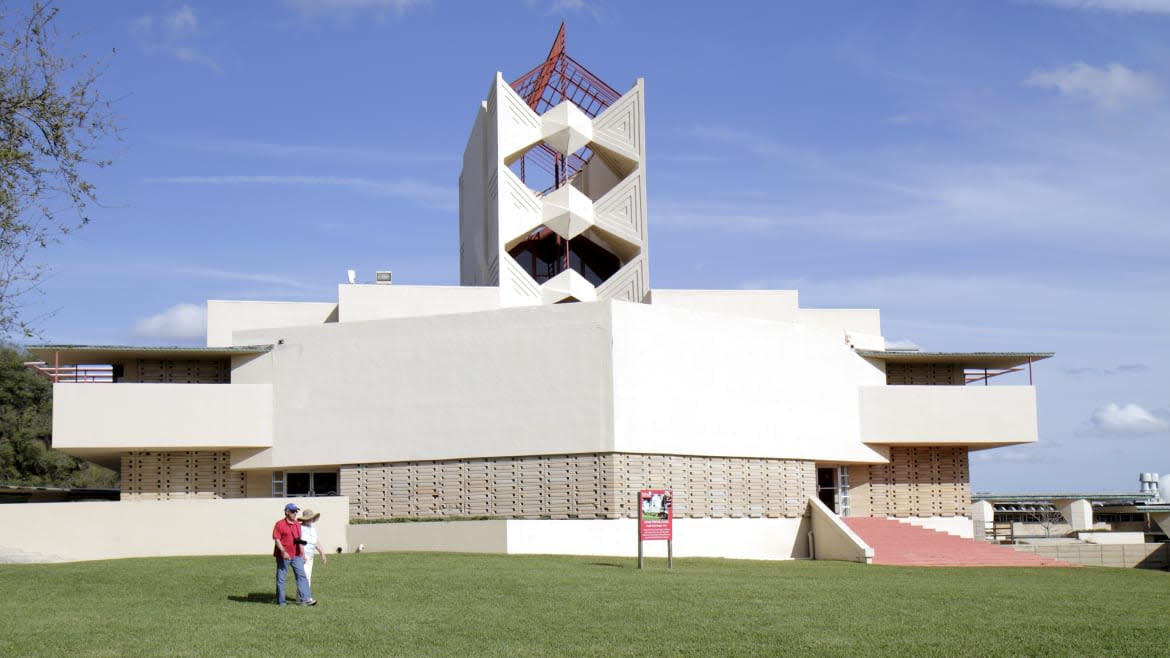
- Oops!Something went wrong.Please try again later.
If you’ve made a few or many stops along America’s Camino de Santiago of Organic Architecture venerating the relics of Saint Frank, you will know well the fear of accidentally grazing a surface and drawing reprimand from the worshipful scribes. You will encounter a much greater shock early on in your tour of Florida Southern College—in the very first building, a house—an invitation to sit down, in Wright-designed furniture!
Now to be clear this building, a faculty house, was constructed in 2013 from Wright specifications and is accordingly at no risk of collapse from time, and yet it augurs a tour of a different sort from most Wright sites, one of a campus in active use where engaging with features of the site don’t prompt a second thought. There are obviously other Wright ensembles that are working places and not just reliquaries, from the Marin County Civic Center to Taliesin West to the Guggenheim Museum, and yet it’s a rare visit that provides a comparable sense of liberty. It’s also the sole college that Wright ever designed, and the largest set of buildings he designed for a single client in one place.
Lakeland, Florida, 35 miles east of Tampa and 55 miles southwest of Orlando might seem a surprising site for this rarity but Wright buildings are often in locations that require looking up.
It exists, as with many of his buildings, mainly because someone simply asked him in 1938, namely Ludd Spivey, president of Florida Southern University, a Methodist institution. There aren’t many Wrights in Florida but that’s because there weren’t enough Spiveys there.
A huge merit is the opportunity to see Wright structures designed over 20 years, a chance to catch not just moment in his design thinking but two decades of them. The process was of course a slog in many ways, bristling with irate letters, delayed payments, foremen firings, workmen bewildered by blueprints, denials of steel by the war production board, and more, and yet progress endured with 12 buildings completed during Wright’s lifetime (and the one, that faculty house, in 2013).
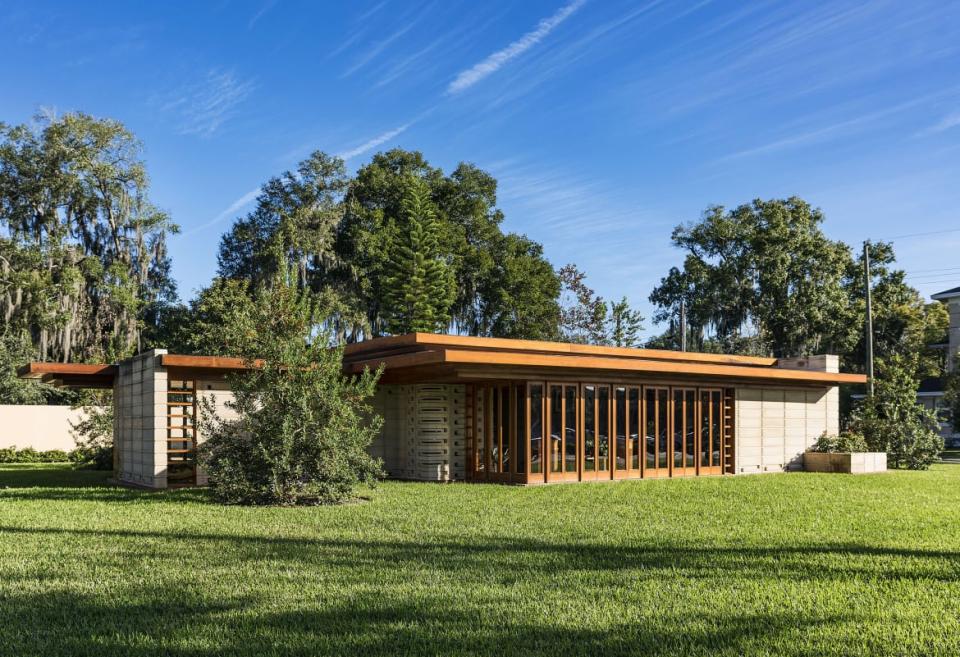
Usonian house.
None of this drama need weigh on your experience of navigating the campus, which is purely fun. Lakeland is not Florida-flat but located along a chain of hills so things move up and down a bit. The most striking immediate feature of the campus—also, it was soon apparent, the most helpful, given a biblical downpour that emerged abruptly out of a sunny day—is its series of esplanades, tendrils undulating up and down slopes at diagonal angles that tie the campus together in an unusual and unusually charming fashion. Sometimes they line buildings as arcades, at other times snake deliberately apart, sometimes they’re incised to provide light to planters below.
The campus has lost a fair number of orange trees over time (the college means to replant) but portions are verdant and the esplanades offer a frame for experiencing both nature and Wright’s work that makes for interesting views at almost every point. The harmony between man and nature is reinforced by columns with capitals that broaden at the top with semi-arboreal detailing (paired with very modern thin flat roofs. You can also sense when moving around the campus that Wright was exercising a Kandinsky-esque desire to create buildings in new shapes at every turn, a tendency that might have been jarring but isn’t with the esplanades to tie it all together. They are literal and visual links, or as Wright put it, the esplanade “runs all over and finally gets together and makes a building.”
Wright’s work might have been a surprise given his incendiary proclamations about Higher Education. In his autobiography he wrote, “Were I a Rockefeller—Ford—or Dupont, I mean as rich, I would buy up our leading universities—close them and hang out the sign—closed by the beneficence of one, Frank Lloyd Wright.” Yet an offer of work overcame this scruple, as it often does. In fairness this was a different sort of university, with Spivey a John Dewey-influenced progressive Methodist educator who wanted to produce a campus for the modern age. It’s also arguably the first campus in the entire country constructed in non-traditional style.
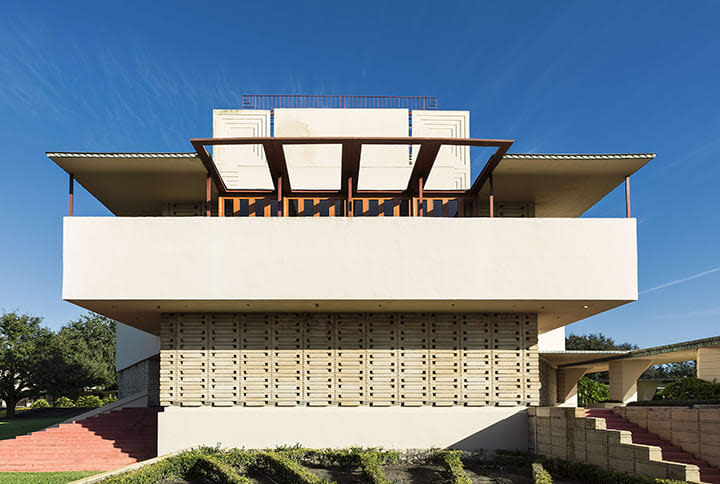
Annie Pfeiffer Chapel.
Wright’s intentions and results were of course unique. He did not care for Florida’s predominant architectural styles (any more than he cared for those almost anywhere). He observed “No real Florida form has yet been produced. Most of you here have simply built as you built back home.”
The absence of a Florida style left Wright free to invent one. He proclaimed, “every building is out of the ground into the light—a child of the sun.” whatever that means, but Wright did design specifically for the climate and generally very well.
Dale Allen Gruyere in his monograph on the campus notes:
“For Florida, a place with little regional heritage, he sought to create an assembly of buildings that responded to the hot and sunny climate, the topography and lake, and the surrounding citrus groves. The intention can be seen in a number of design elements. Covered walks provided shelter from the sun and frequent summer rains. Except for the two chapels, Wright’s buildings had few instances of large glass expenses or direct lighting. Sand from the site and coquina, a Florida limestone made of crushed seashells, were used to make concrete blocks used in all the buildings, further tying the structures to their locale.”
There is an unusually lengthy tour available at two and a half hours, which avoids the sense of rushing past anything and provides interior access to multiple buildings; and does involve multiple pauses to sit (also a helpful emissary arriving bearing umbrellas). Earpieces also enabled wandering away from direct audible range, a great means to enable relative free ranging without missing any detail.
The campus features some buildings meant to fade to the background but several designed to make a splash, particularly the Pfeiffer Chapel, the tallest on the campus, and picturesque from multiple points. It pivots into three different geometrical forms as it rises, an avant-garde Methodist wedding cake, with two different concrete lower geometries topped with a series of steel-framed glass roofs at the top. You enter into a characteristic Wright compressed cloister behind the pulpit but are lead to a bright grand space which turns your eye heavenwards. Inside there are no columns, with a cantilevered balcony level hovering above. Patterning persists throughout, with a cypress pulpit, concrete blocks carved through to provide semi-concealment of the choir loft, and thousands of pieces of colored glass lining concrete blocks.
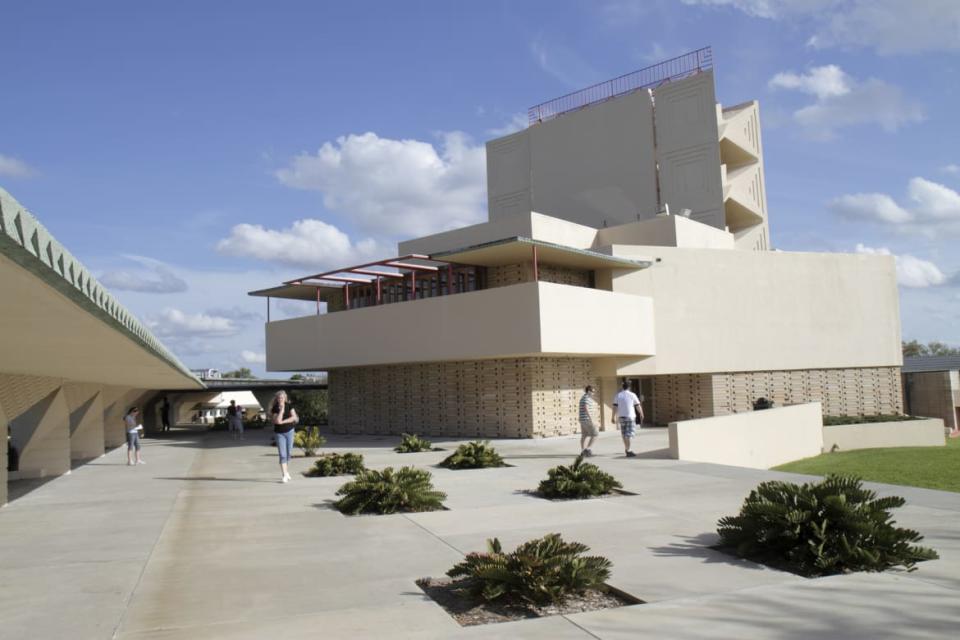
The exterior of Annie Pfeiffer Chapel.
Wright used a common material palette for the campus, with its most luxe element being Florida Cypress trees whose logging is far more restricted than it once was, otherwise turning to steel, glass, copper, and concrete blocks.
The campus tour is worth it alone just for the possibilities of concrete block design, a thought that might seem hyperbolic until you see them. These are not the drab blocks you’ve found elsewhere, instead these have intricate patterns providing reliefs on countless walls. These required all sorts of work to get (W)right. The color was difficult to devise, as was suitable strength. Wright wanted to use local sand but this produced blocks that collapsed. Ultimately a proper shade was achieved in typically Floridian melting pot fashion with a blend of sand from Daytona and California cement.
Another quirk of the college was the character of its labor force at a number of points. Wright was no stranger no monetizing student labor—see the Taliesin Fellowship—but rarely did other people’s students work for him, the effective circumstance of Florida Southern being not the sort of well-heeled institution that usually commissions starchitects but an at-times financially strapped central Florida Methodist college. Arrangements were made for students to work three days a week in return for tuition credits. Students were often not skilled builders, which resulted in some hiccups but eventually results were achieved.
The flaws that sometimes marred Wright buildings were often found in structures built by experts as well so we can admire these amateurs. Another early welcome sign of levity was a tour guide’s question. “How do you know you’re in a Frank Lloyd Wright structure? They leak.”
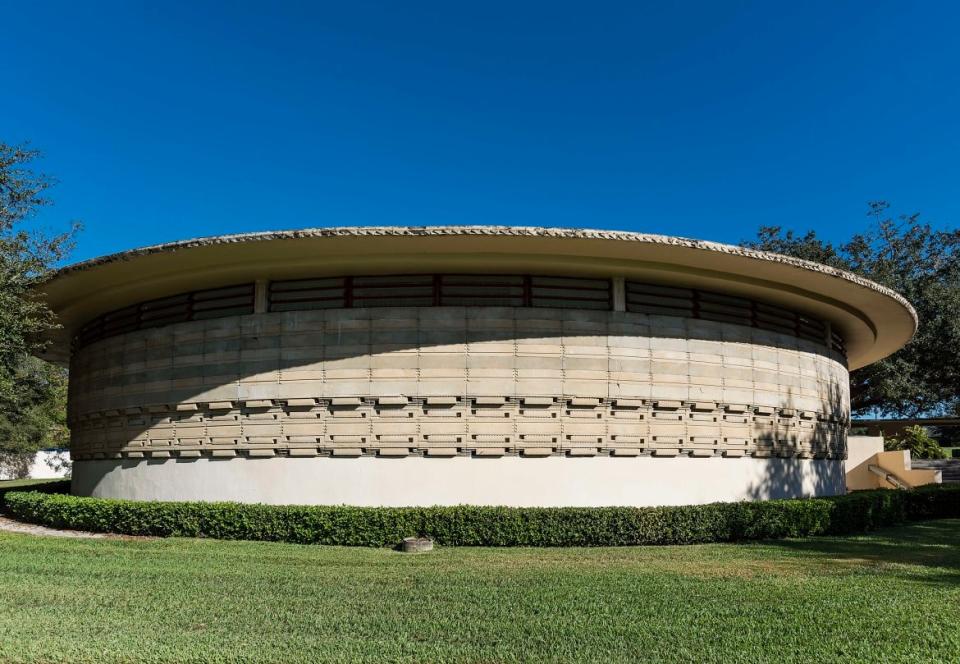
Thad Buckner Building.
Seminar buildings display some of the varieties of test brick colors (waste not, want not!). They’re also skillfully designed with windowless seminar rooms lit by skylights and other small penetrations. They’re something of a reverse of the Wright compression-and-release formula, otherwise airy and well-lit on the exterior.
His two administration buildings are even a charm, clustered a few steps down around a smaller courtyard with incised esplanade There’s even the impression of a grand entrance at one, which of course isn’t a door but a columnar front giving views into a double height atrium.
His library, now a conference space, was unfortunately occupied by a meeting but is a grand structure in photographs, with a circular reading room lit by triangular skylights and clerestories.
The library was a functional fail on Wright’s part. Invariably being dimly lit (Gothic bugbears persisting) it was outstripped by time and a growing collection (a newer library, also of interest, was built by a Florida Taliesin apprentice, Nils M. Schweizer).
Other buildings are unusual in the Wright oeuvre, such as the Ordway Industrial Arts Building, a striking warehouse-like space with more than a taste of early modern factories such as those of Peter Behrens. Its roof is similar to the refectory at Taliesin West and it is unique among Wright structures for a vague air of a factory floor. It also contains his sole theater in the round.
His Science Building also has a Bauhaus look, ornamented with aluminum columns which began to be used in later years of construction. Inside there’s a Marin Civic Center-like atrium spanning two levels. Off to the upper floor is the sole Wright-designed planetarium, obviously yet another circle.
There’s another curiosity, a second chapel, the Danforth, the sole Wright building detached from the esplanade and a much more Prairie-styled work, a surprising throwback to his earlier design vocabulary, gable-roofed with a somewhat less eccentric concrete block pattern. It features a dazzling red and white checked stained glass window. There are demotic plywood benches.
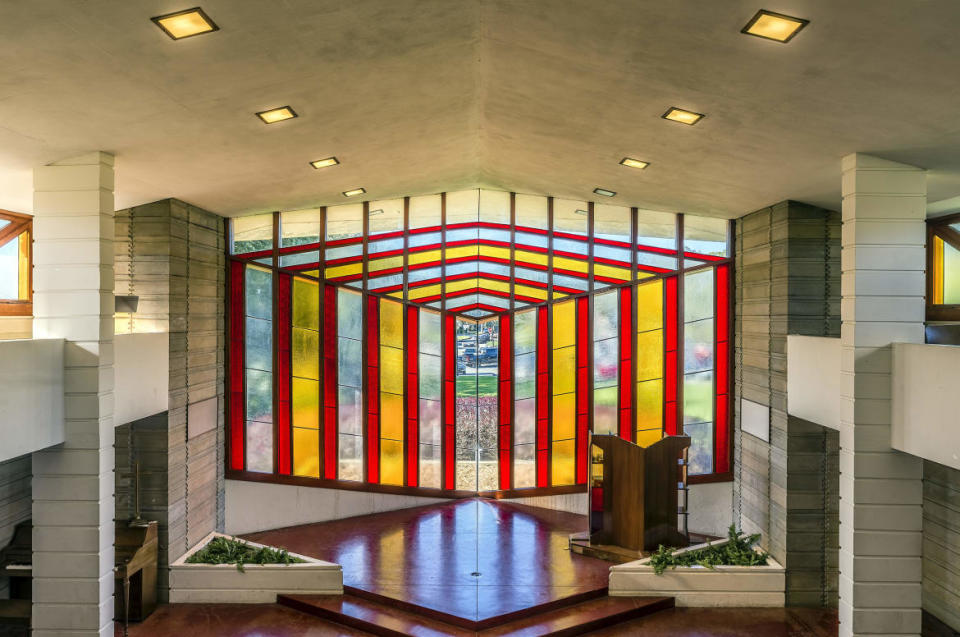
Danforth Chapel.
The faculty home is splendid, with window walls on two sides alternating with more private spaces. There are details to enthrall around every corner. Concrete blocks are cut-through and ranged against stained glass in multiple ways. Bookshelves span windows. While neither you or anyone else can cook in the kitchen (stove and refrigerator were left out to meet building codes) you can experience the home from the rare vantage of sitting down in Wright barrel chairs and benches and ottomans, which as you know would get you thrown out of most Wright homes.
And let’s not neglect the campus’ centerpiece, the water dome: 160 feet wide, it was to feature jets of water spiraling up to create an impressionistic dome. The plot was built out but functioned more as a reflecting pool with a small fountain at the center. The mechanism was never quite finished and according to subsequent evaluations the mechanism couldn’t have reached adequate pressure to achieve anything like a dome of water. In 2007 Wright’s plan was realized with the help of more contemporary technology, on a slightly smaller scale of 140 feet, which I suspect is still quite a bit larger than any of your other water domes. This is one spot you can’t venture in; the tour guide pointed out that taking a dip in the dome incurs a 60,000-dollar fine.
Thirteen buildings by Wright is a pretty good tally but some went missing along the way. Six never made it off of the drawing board. The additions by Scheizer are interesting in their own right but of a slightly jarring height compared to their lower-slung Wright neighbors.
It’s an entirely unique space well worth a trip for the Wright superfan or the more casual sun-seeker. You can take Wright at his word for once on his design, “Each building is individual in character—practical in effect—yet contributes its share to an occult symmetry—delightfully informal and easy as a whole.”
Get our top stories in your inbox every day. Sign up now!
Daily Beast Membership: Beast Inside goes deeper on the stories that matter to you. Learn more.

